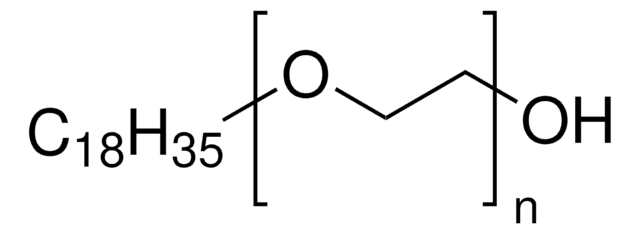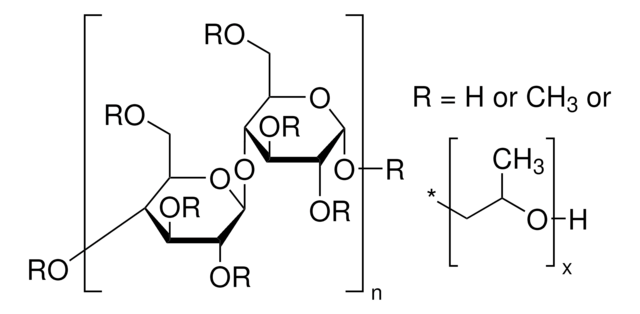STS0213
ECO BRIJ® O10
Sinónimos:
Brij® O10, Brij 97, C18-1E10, Polyoxyethylene (10) oleyl ether
About This Item
Productos recomendados
description
non-ionic
Quality Level
form
semisolid
mol wt
~709 g/mol
greener alternative product characteristics
Use of Renewable Feedstocks
Design for Degradation
Learn more about the Principles of Green Chemistry.
sustainability
Greener Alternative Product
impurities
≤3.0% water
mp
25 °F
acid number
≤1.0 mg KOH/g
hydroxyl value
75‑95 mg KOH/g
solubility
water: 100 mg/mL, clear, colorless to faintly yellow
density
1 g/mL at 25 °C (lit.)
HLB
12.4
greener alternative category
, Aligned
SMILES string
O(CCO)CCCCCCCC\C=C/CCCCCCCC
InChI
1S/C20H40O2/c1-2-3-4-5-6-7-8-9-10-11-12-13-14-15-16-17-19-22-20-18-21/h9-10,21H,2-8,11-20H2,1H3/b10-9-
InChI key
KWVPFECTOKLOBL-KTKRTIGZSA-N
¿Está buscando productos similares? Visita Guía de comparación de productos
General description
Application
Features and Benefits
- 100 % Renewable
- 100 % Bio-based
- Certified to the USDA BioPreferred Program
- Lower carbon footprint than petrochemical-based versions
- High-purity chemical suitable for a wide variety of research applications
Physical properties
Other Notes
Legal Information
signalword
Warning
hcodes
Hazard Classifications
Aquatic Chronic 2 - Skin Irrit. 2
Storage Class
11 - Combustible Solids
wgk_germany
WGK 1
flash_point_f
>464.0 °F - Equilibrium method
flash_point_c
> 240 °C - Equilibrium method
Elija entre una de las versiones más recientes:
Certificados de análisis (COA)
It looks like we've run into a problem, but you can still download Certificates of Analysis from our Documentos section.
Si necesita más asistencia, póngase en contacto con Atención al cliente
¿Ya tiene este producto?
Encuentre la documentación para los productos que ha comprado recientemente en la Biblioteca de documentos.
Nuestro equipo de científicos tiene experiencia en todas las áreas de investigación: Ciencias de la vida, Ciencia de los materiales, Síntesis química, Cromatografía, Analítica y muchas otras.
Póngase en contacto con el Servicio técnico






